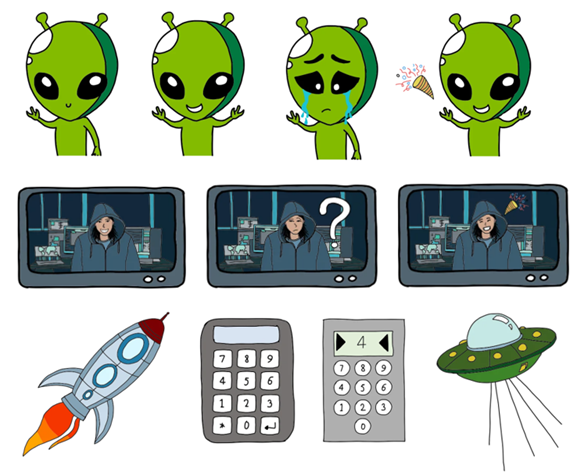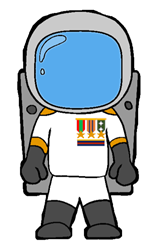Visualizations
Learn more about the design and implementation of our application's visual elements.
Contents
Motivation
Visualizations play a central role in the field of user experience. Because of their great potential, they were included in Escapeling. Firstly, in the previous semester’s report it can be found in the outlook that the application should contain more visualizations. Secondly, this semester the idea of visualizations especially for the adaptive and situational elements was brought forth. Visualizations can be simple emojis, as well as situational gifs or adaptive images. The usefulness of visualizations in a learning environment has been proven in many ways. Our app is explicitly not about visualizing vocabulary using images, for example, as is common in beginner courses. Rather, different types of visualizations have been used as supporting elements to both enhance the user experience and maximize learning. For example, the main characters of our story have been given a face by creating stickers of them that are sent to the user.
Theoretical Background
Visualizations “displayed in online interactive e-learning (…) represent a critical aspect in teaching and learning” (Jusoh, 2019). Among other things, the study shows that visualizations in e-learning increase the interest in the subject matter (Jusoh, 2019). Furthermore, visual stimuli can help to focus on the learning content as well as to remember what has been learned (Jusoh, 2019; Zallio, 2018). The emotional aspect of emojis and GIFs as facilitators in learning should also not be underestimated. According to ISO 9241-210 (2019), the user’s emotions are also part of the user experience. In a study by Zallio & Damon (2018) that examined the use of emojis and GIFs to promote student engagement, these visualizations were used “in order to stimulate the emotions such as hilarious and ironic feelings among young students”. This is consistent with other findings highlighting the role of emotions in learning processes. For example, it “is known that long-term memory retention is greatly aided by the emotional associations of that memory” (Zallio, 2018). Finally, visualizations also contribute to an appealing design of the learning application. According to Don Norman, a professor well known in the field of design, attractively designed applications are evaluated as more usable by the user than unattractive ones. To a large extent, this is due to the influence of emotions (Norman, 2005). This could improve the user’s subjective evaluation of the learning app, as well as their feelings about the app’s usefulness.
Conception
Previously, the app contained very few visualizations. These consisted of one single video, one image and three different emojis indicating which character is speaking. Our goal was to make visualizations a vibrant part of the storytelling and task support throughout the game. The selection of the type and manner of visualization elements was based on both the use of these elements by our target audience – mostly 15-year-old teenagers – and the functionalities of our app. These two points led us to a specific selection of the following media: GIFs, emojis, stickers and adaptive images.
GIFs

Figure 1: GIF showing the view out of the spaceship after escaping the aliens
GIFs are short, constantly repeating videos. On the one hand, they can have a pictorial character, such as a GIF shown at the end of the Escapeling story, where the player flies back to Earth in a spaceship, seeing the Earth approaching him. This view is shown in a GIF. Furthermore, a GIF can be used to draw focus to important learning sections. According to a study by Zallio & Damon (2018) “it is possible to confirm that it is easier for students to better understand certain topics after showing emoticons or GIFs. (…). This is an element that highly stimulates the attention and by levering on emotions, students are more likely to focus their attention after the given emotional stimul[us]”. For this reason, each of the learning tasks is introduced with a GIF. This marks the intersection between the previous storytelling and the subsequent task, which again fully demands the user’s attention. The third function of using GIFs in Escapeling, is to provide feedback and motivate. For example, a GIF can be sent in response to a correct answer, or to repeated failure when guessing a word in the vocabulary guessing task.
Emojis

Figure 2: emojis in the private chat selection menu
Emojis are small graphics that can be in a line with text. They can be emoticons, representing emotions, as well as representing unemotional things. For quicker orientation, for example, emojis were inserted in the private chat selection menu. This additionally made the previously completely text-based selection a bit more colorful, and various studies have proven that colors can stimulate the brain during learning (Ferrari, 2008) (Althouse, 2003).
Situation Dependent Images

Figure 3: image showing the remaining time for a task
In some tasks it is useful to know how much time you have left to complete the task. Since Telegram’s API does not allow the implementation of a progress bar, other ways had to be found to implement this. The challenge was solved by sending an image at certain points in time showing the time left to complete the task.
Stickers

Figure 4: example sticker of the alien Elias
Stickers are images that have no background. They are displayed much larger than emojis in Telegram, the platform used for Escapeling. To enhance the effects of storytelling, a standalone sticker pack was developed that incorporates various components of storytelling. The full content of the sticker pack can be seen in Fig. 5. It includes the main characters of the story, Harriet and Elias. Since emotions can be an essential factor for learning and provide a better experience of the story, different emotional states of the main characters such as joy, mistrust or sadness are visualized. Other storytelling elements were also visualized with the help of stickers, such as the code panel, on which the player is supposed to enter a code several times during the game.

Figure 5: all stickers belonging to the Escapeling sticker pack
Achievements
As part of the visual overhaul of the app, the medals awarded in the “Achievements” section have also been visualized. You get these for playing Escapeling frequently, for example. Previously, achievements were purely text-based, but now the player receives a picture of their current status.

Figure 6: image that the user gets when he has reached the status of an “Admiral” as part of the achievements
Implementation
The changes mentioned above have been implemented as follows:
Emojis
Emojis are handled by tags like “:alien:”. These tags where transformed to the correct emoji by using the emoji-package for python (Kim and Wurster, 2021).
Stickers
Stickers in telegram are handled by using so called IDs. If you upload a sticker to telegram an ID is created. To send a sticker, get_sticker_id() is called to retrieve the ID from a .json file, based on the name of the particular sticker. This improves readability and centralizes the organization of the stickers in the .json file. The Escapeling sticker pack was created by freehand drawings on an iPad using Adobe Fresco software. To turn these drawings into a Telegram sticker pack, they were sent to a Telegram bot called @Stickers.
GIFS
Since Telegram does not support an ID system for GIFs we used URLs from GIPHY, a website that collects GIFs. These URLs are organized based on keywords in a .json file, which can be accessed by using the function get_gif_link(). GIFs can be sent into the chat with send_animation().
Images
The various achievement images were created with GIMP 2.10. In the future it might be possible to put additional information about the achievements as additional layers over the current images, so that one image shows all achievements at once. This could be done using the Python Image Library (PIL). They can be sent to the chat with send_image().
Outlook And Discussion
The visualizations received very positive feedback after initial user tests, which is why it can be assumed that they achieved their goal of enhancing the user experience. In future implementations of further tasks and changes to storytelling elements, care must be taken to select suitable visualization elements or to adapt existing elements.
One point that should not be ignored, however, is that too many graphics could distract learners more than focus them (Zallio, 2018). In addition, especially GIFs and emojis could lower the seriousness of the application (Zallio, 2018). While it is desired to break away from what is often perceived as a strict school learning environment and also to convey the joy of learning, Escapeling should also not be perceived as chat game without a serious English learning intention.
In order to avoid these effects, it is important not to include too many visualizations at once and to use GIFs and emojis in a well-dosed way. Further user tests will show whether the current implementation is successful.
References
Althouse, R., Johnson, M.H., & Mitchell, S.T. (2003). The colors of learning: Integrating the visual arts into the early childhood curriculum; Vol. 85, Teachers College Press
DIN EN ISO 9241-210:2020-03, Ergonomics of human-system interaction - Part 210: Human-centred design for interactive systems (ISO 9241-210:2019)
Ferrari, V., & Zisserman, A. (2008). Learning visual attributes. Advances in neural information processing systems, 433–440.
Jusoh, S., Almajali, S., & Abualbasal, A.M. (2019). A study of user experience for e-learning using interactive online technologies. Journal of Theoretical and Applied Information Technology, 97(15), 4036-4047
Norman, D. A. (2005). Emotional Design: Why We Love (or Hate) Everyday Things. Basic Books.
Zallio, M., & Damon, B. (2018). Computer Aided Drawing software delivered through Emotional Learning. The use of Emoticons and GIFs as a tool for increasing student engagement. 1-4. 10.14236/ewic/HCI2018.75.